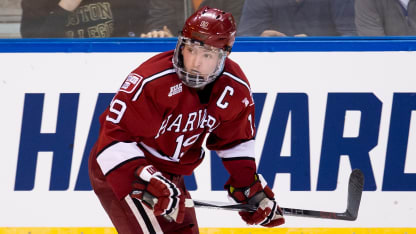Not all scoring is equal
Vesey had 46 points (24 goals, 22 assists) in 33 games at Harvard last season, and his 1.39 points per game translates to 0.32 points per game at the NHL level.
That estimate is based on a method for translating data from other leagues, first developed in baseball by Bill James in 1985, and introduced to hockey by Gabriel Desjardins 20 years later. Essentially, this process calculates the average change in individual scoring levels of all players who went directly from the target league to the NHL in the past.
When completing these calculations for U.S. collegiate players, it's important to break them down by division and by conference. NCAA Division I hockey is divided into six conferences of varying scoring and competition levels, so the translation factors will be different in each case.
Harvard is in the Eastern Collegiate Athletic Conference (ECAC), which has a translation factor of 0.23. By comparison, Eichel (Boston University) and Gaudreau (Boston College) played in Hockey East, which has a translation factor of 0.37. That means NHL players coming from Hockey East historically have retained more of their scoring than those coming from the ECAC.
Very few players have gone from the ECAC to the NHL without spending at least one season in the American Hockey League. The last to do so and have at least 20 points in his rookie season was Lee Stempniak, who played at Dartmouth College and then had 27 points (14 goals, 13 assists) in 57 games for the St. Louis Blues in 2005-06.
Age also is an important consideration when estimating a player's rookie scoring totals, because a player's size, ice time and scoring can increase dramatically every season. At Boston College, Gaudreau had 51 points (21 goals, 30 assists) in 35 games as a 19-year-old and 80 points (36 goals, 44 assists) in 40 games at age 20. Eichel, in his only season at Boston University, had 71 points (26 goals, 45 assists) in 40 games at age 18. Vesey had his highest point total, 58 (32 goals, 26 assists) in 37 games, when he was 21 two seasons ago.
That's why there's a big difference between those who can be dominant scorers as teenagers, like Eichel and Gaudreau, and those who do so at age 21 or beyond, like Vesey, who turned 23 in May.



















